Quick search
CTRL+K
Quick search
CTRL+K

London is the center of the British world, and as the capital of an empire, the city has for centuries been inspired by cultures around the world, and it has left its mark in the city’s streets. London is a metropolis, with something for everyone; it goes for sights, monuments, museums, activities and also the many ethnic restaurants and cultural features that are here.
The museums in London are among the finest in the world and there is something for everyone in British Museum’s fantastic collections. Imperial War Museum and Tower of London are other popular choices. You can find almost anything in the English Capital, just use your imagination and curiosity.
Buckingham Palace, the city’s churches, the political institutions, the landmarks and the many interesting buildings of modern and experimental architecture are also worth noticing. An underground ride with the London Underground should also be included when in London; the old stations are particularly interesting.
For many, a visit to London is also an opportunity for shopping, and you can find it all in the many department stores and high street shops in the city center. There are also many restaurants of the city, not least representing England and every part of the British Empire.
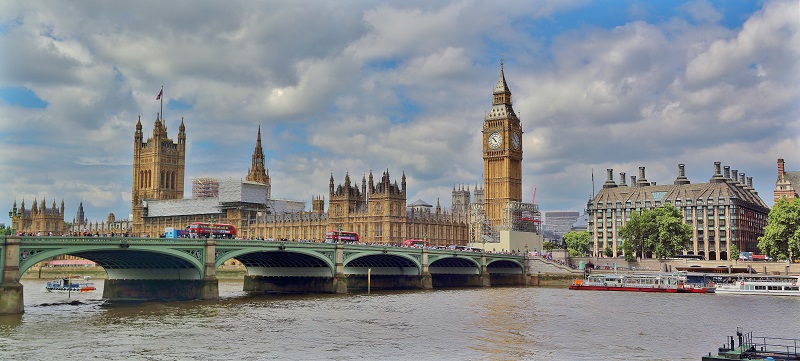
When you hear the name Big Ben, most people think of the clock tower at London’s Westminster. However, it is the big bell in the tower that is called Big Ben, while the official name of the tower itself is Elizabeth Tower. It was in 2012 that the otherwise nameless tower was named after the English queen in connection with her 60th anniversary on the throne.
Elizabeth Tower was built as part of Charles Barry’s plan for a new palace to replace the Palace of Westminster, which burned down in 1834. It was designed by Augustus Pugin and is in his famous Neo-Gothic style.
Dimensions of the Elizabeth Tower are 96 meters in height. The dials measure 7 meters in diameter, while the hands of the clocks are respectively 4.3 meters and 2.7 meters long. The clock is also made according to Augustus Pugin’s drawings, and under the dials you can see the inscription: “Domine salvam fac reginam nostram Victoriam primam”, which alludes to God’s protection of Queen Victoria I.
Big Ben is the tower’s largest clock, and was first cast on 6 August 1856 in Stockton-on-Tees. The bell was named after Sir Benjamin Hall, whose name was also inscribed on it. Big Ben weighed 16 tons and 16 horses pulled it to London. During testing, the bell broke and a new one had to be cast. It happened on 10 April 1858 in London with a weight of 13.5 tons. It took 18 hours to hoist the bell 61 meters up, and it too broke. It happened because of the hammer, but Big Ben could be repaired this time, and since then the tone has been slightly different from the original.
Westminster Palace is one of London’s landmarks and the meeting place for both the British upper house, the House of Lords, and lower house, the House of Commons. The two houses are collectively known as the Parliament/Houses of Parliament. Westminster Palace is located on the banks of the Thames, and the large building complex is named after Westminster Abbedi/Westminster Abbey, which is located immediately northwest of the palace.
The current palace is the newest of the two versions of Westminster Palace that have stood here over the years. The first royal palace on this site was built in the 11th century, and it was the residence of the British kings until a fire destroyed large parts of the buildings in 1512. After the fire, Parliament continued to have its seat in the palace buildings, which were rebuilt over the years. Several other institutions, such as the country’s Supreme Court, were also housed in the palace, which, until another fire in 1834, was built significantly differently than before 1512. The king officially moved to Whitehall Palace later in the century.
With the fire of 1834, only a few parts of the first Westminster Palace survived; it concerned, for example, Westminster Hall and the Jewel Tower. After the fire, the architect Charles Barry was given the task of rebuilding the palace. His design is grand neo-Gothic, and with the exception of the Jewel Tower, the remains of the former Palace of Westminster were contained in the new building complex. The new palace was also significantly expanded, and it came to accommodate more than 1,100 rooms and halls, part of the decoration of which was designed by Augustus Pugin.
Westminster Palace was completed after around 30 years of construction in 1870. The whole consists of a 266-metre-long facade facing the Thames and a neo-Gothic style, historically based on the Gothic style of the 15th century.
There are three main towers in the Westminster Palace building complex. To the north is the Elizabeth Tower, better known as Big Ben, while the 91-metre-high Central Tower sits octagonally above the central hall of Parliament. The tallest and most substantial tower is to the south. It is the Victoria Tower, which reaches a height of 98.5 meters.
At the foot of Victoria Tower is the royal entrance, which the British monarch uses when, for example, Parliament is to be opened. The monarch conducts various ceremonies at Westminster Palace, which formally remains the royal palace despite not being the royal residence.
Inside, the two best-known rooms are the upper house’s Lords Chamber and the lower house’s Commons Chamber. In the Lords Chamber there is a lavish decoration, and here the monarch also has a throne. In front of the throne is the so-called Uldpude/Woolsack, which represents the historically important trade in wool.
At the northern end of the palace is the Commons Chamber, which in its current decoration was opened in 1950 due to the destruction of the Victorian interior during the Second World War. Green benches facing each other make room for government parties and opposition in often quite lively debates. In addition, the hall is too small to provide seating for all members of parliament, so for important votes, standing room is also used.
A third impressive hall is Westminster Hall, which is the oldest surviving part of the Palace of Westminster. The hall was built in 1097 as the largest hall in Europe. However, the original roof construction was replaced at the end of the 14th century. The hall has, among other things, been used for monarchs’ coronation banquets.
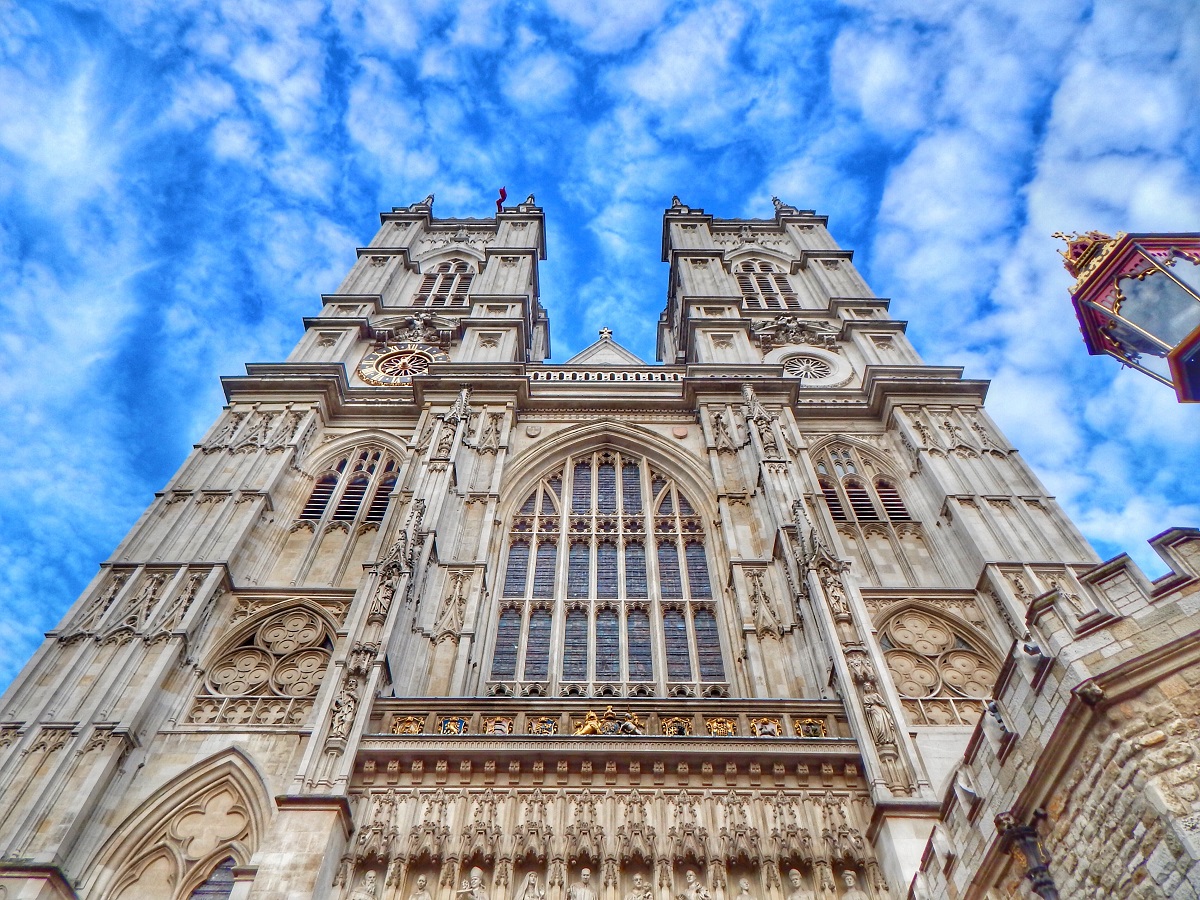
The large and noble church Westminster Abbey was founded as a monastery in 1065, and already the following year it became the coronation church for first the last Saxon king, Harold Godwinson, and the Norman William I. Since then, British monarchs have been crowned here and laid to rest from here, and it has thereby laying floors for countless large ceremonies.
Despite the name, the church is not an abbey today. Between 1540 and 1550 it had the status of a cathedral, but since 1560 it has been called Royal Peculiar, which is the term for a church that belongs directly to the British monarch and is therefore not subject to a bishop’s see.
The coronations themselves have taken place since 1308, where the main character has sat in the King Edward’s Chair, which is kept in Westminster Abbey. In addition to coronations and funerals, many royal weddings have also been held at Westminster; including for the sitting monarchs Henry I and Richard II. Of recent events, Pope Benedict XVI visited Westminster Abbey as the first pope on 17 September 2010.
From 1245 the church got its current Gothic appearance. The rebuilding was then initiated by King Henry III. Part of the western facade is newer, however, and the church’s two towers were built in the years 1722-1745. However, the different building periods have all followed the same elegant Gothic exterior, whereby the church appears in harmonious architecture.
The interior of Westminster Abbey is worth seeing. Immediately after the entrance, you are greeted by the impressive and stylish Gothic church room with vaults high above floor level. In addition to the many elegant building details, you can take a tour past the interesting chapels. Among them is King Henrik VII’s chapel from 1503-1519, and it is considered one of the finest of its kind from the late Gothic period in Europe.
You can also see a number of royal tombs; not least the founder of the church, St. Edward, whose sarcophagus is the holiest relic kept in Westminster Abbey. In the church there is also a museum, which is set up in part of the earliest building from 1065. At the museum you can experience various royal effects and other treasures from the church’s history.
Adjacent to the church Westminster Abbey itself are two other beautiful buildings; Chapter House from 1245-1253 and the associated monastery. The Chapter House is octagonal and offers a particularly beautiful interior with fine mosaic windows, while Westminster Abbey’s cloister is an idyllic monastic environment with elegant archways around a cloister courtyard.
Tower Bridge is a combined folding bridge and suspension bridge that, with its distinctive architecture and central location, has become one of London’s world-famous landmarks. That name comes from London’s old castle, the Tower of London, which is located close to Tower Bridge on the north side of the River Thames.
The bridge’s history started with London’s development in the 1800s. Throughout this century there was increasing traffic and trade in East London, and a need had arisen for a bridge east of London Bridge. There was also traffic on the Thames to the port areas at the Pool of London, and therefore a traditional fixed bridge such as London Bridge could not be built.
In 1877 a committee was set up to ensure the development of a solution, and it came up with Sir Horace Jones’ proposal, outlining a bridge with the current solution. Construction started in 1887, and the bridge could be inaugurated on 30 June 1894 by the later King Edward VII and his wife, Alexandra of Denmark.
Tower Bridge is 244 meters long and each of the two towers is 65 meters high. The towers are neo-Gothic and built with covered walkways between them at the top. That way you could still cross the Thames when the bridge’s clapboards were up to street level. From the top of Tower Bridge the view is very fine; among other things to the Tower of London to the north-west. Today, it is rare for the bridge flaps to open. This often happened earlier and also during the construction of the bridge due to the heavy traffic on the Thames.
On a visit to Tower Bridge, you can try the Tower Bridge Experience, which, in addition to a trip to the top, offers old photographs and films from the construction as well as a visit to the original machines that operated the bridge flaps from the bridge’s opening.
The Tower of London is the Normans’ old castle, which is located on the Thames and was part of their conquest of England. The construction of the Tower of London castle was begun in 1066, and it was under William I the Conqueror that the White Tower was erected in 1078. The tower came to give the name to the entire facility, the Tower of London, which was supposed to ensure the Normans’ control of The Thames and London. The White Tower was also built as a royal residence, allowing the king to stay here. It was and is thus one of the finest royal palaces built around the year 1100 in Europe.
The Tower of London stands today as a castle complex with the White Tower as the central building with four corner towers and a height of 27 metres. This building was built so that it stood as a symbol of power against Anglo-Saxon London, which in the 11th century lay west of the castle.
Around the White Tower, which is the oldest part of the castle, there are two ring walls, of which King Richard I the Lionheart had the innermost one built in the 1190s. The outer wall dates from the time of King Edward I, and in addition to the wall, he carried out some remodeling of the Tower of London, which was completed in its current layout in 1285. After this, however, the Tower’s yard was built on the Thames in the last decades of the 1300s century, and in the 15th century the White Tower’s top floor and current roof structure were built.
Surrounding the White Tower are various buildings that have been built over the centuries. Among them are the Waterloo Barracks immediately north of the White Tower and the Chapel Royal of St. Peter ad Vincula to the northwest.
Today, the Tower of London stands beautifully as one of London’s landmarks and one of Europe’s most beautiful castles from its time. The castle complex itself is worth seeing, and it is also here that you can experience the well-known Beefeater guardians, whose formal name is Yeomen Warders. They originated as the king’s personal bodyguards in 1485 under Henrik VII. Their role as bodyguards ceased under King George II, and today the finely uniformed guards are a delight to visitors.
For many centuries, the Tower of London served as a prison, and this history can also be experienced here. You can, for example, become familiar with the castle’s role as a torture chamber, and here is a dungeon at Traitor’s Gate. Famous prisoners include, for example, King Henry VI and Rudolf Hess.
The Tower of London is also famous as the home of England’s valuable crown jewels and crown regalia. For many centuries they have been in the Jewel House, whose exhibition can today be seen in part of Waterloo Barracks. The collection of diamonds and jewels is considered one of the world’s most valuable, and here are, for example, crowns, sceptres, royal apples and swords. Saint Edward’s Crown/St. Edward’s Crown is the royal crown itself, which is still used at coronations. It dates from 1662 and is made of solid gold with 444 inset precious stones and pearls, giving it a total weight of 2.25 kilos. Other crowns include the Scottish and the imperial crown from India.
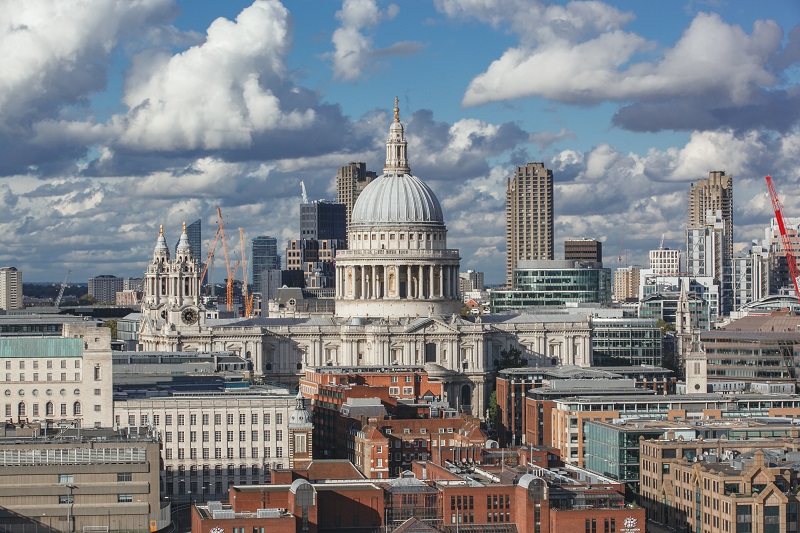
St Paul’s Cathedral is an Anglican cathedral and it is the seat of the Bishop of London. It was built on Ludgate Hill, the highest point in the city of London. Its name derives from the first church on the site; it was founded in the year 604 and dedicated to the disciple Paul.
After the first three churches, the so-called Old St Paul’s was built by the Normans from 1087. The church was consecrated in 1240, and thus there were both Romanesque and Gothic features in the large building. Its dimensions were 178×30 meters and it was adorned by a 149 meter high central spire. The tall spire was struck by lightning in 1561, and the rest of the church perished in the Great Fire of London in 1666.
It was decided to demolish the ruins of Old St Paul’s and build a new and modern church instead. Sir Christopher Wren came to be in charge of the building; he was behind about half a hundred churches in London during this period. The foundation stone was laid in 1675, and the last stone was laid on the building in 1708. In 1711, St Paul’s Cathedral was officially declared completed and thus consecrated. However, building details in the decoration were worked on until the 1720s.
The dominant feature of St Paul’s Cathedral is the majestic dome, which until 1962 was the tallest building in London. The dome was structurally one of the most difficult things to realize; it had to be impressive from the outside with its size, and at the same time the dome had to be suitably close to the churchgoers, so that they could enjoy the decoration as best as possible. The solution was an outer and inner dome with space between them.
The architecture is based on transitions from Renaissance to Baroque style in a variant where Christopher Wren was inspired by Italian Andrea Palladio’s buildings. The large dome and the western facade are the main external features. Inside is a large, beautiful and bright church room, where the elegant decoration can be experienced, among other things, in the dome.
In the church there are various interesting things to experience. Among others, the Duke of Wellington, Horatio Nelson and Winston Churchill are buried in the crypt. In the church is a monument worth seeing of the Duke of Wellington with his horse Copenhagen. The monument was installed after many years in 1912; in the past it was considered inappropriate to place a horse in the church room.
The British Museum is a must for virtually all visitors to London if their interest is in culture and history from virtually every part of the globe. The museum’s collections are among the world’s largest and consist of several million effects from every continent on Earth. There are so many highlights that you can easily spend hours and days in the large building complex.
The museum was founded in 1753 based on the collections of the scientist Sir Hans Sloane, and it opened its doors in 1759 in the 17th-century mansion Montagu House, located on the same site as today’s museum. Montagu House was built by Ralph Montagu, who was the first Duke of Montagu. The mansion was demolished in the 1840s to make room for a larger new building that would house the ever-growing collection.
Since then, the museum has continued to grow, not least through the British colonies and international trade over the centuries. The building has been extended since the 19th century, and one of the spectacular constructions is the arrangement of the central unifying area, the Great Court, in the center of which you can see the beautiful and domed reading room, which dates from 1857. The Reading Room, The Reading Room, is among other things used in several films; for example in Alfred Hitchcock’s Blackmail from 1929.
Among the large museum’s many top attractions from present and past cultures, we can mention the friezes from the Athens Parthenon on the Acropolis and countless Egyptian treasures such as sphinxes and mummies. The Rosette Stone, discovered during Napoleon’s campaign in Egypt in 1799, is also here; it later became the key to deciphering the Egyptian hieroglyphs.
Parts of the mausoleum in Halicarnassus, one of the seven wonders of ancient times, and an original stone figure from Easter Island can also be experienced. Fantastic and unique finds and works are thus found to such an extent that one can spend several days at the museum and still only have seen a small part of the collections.
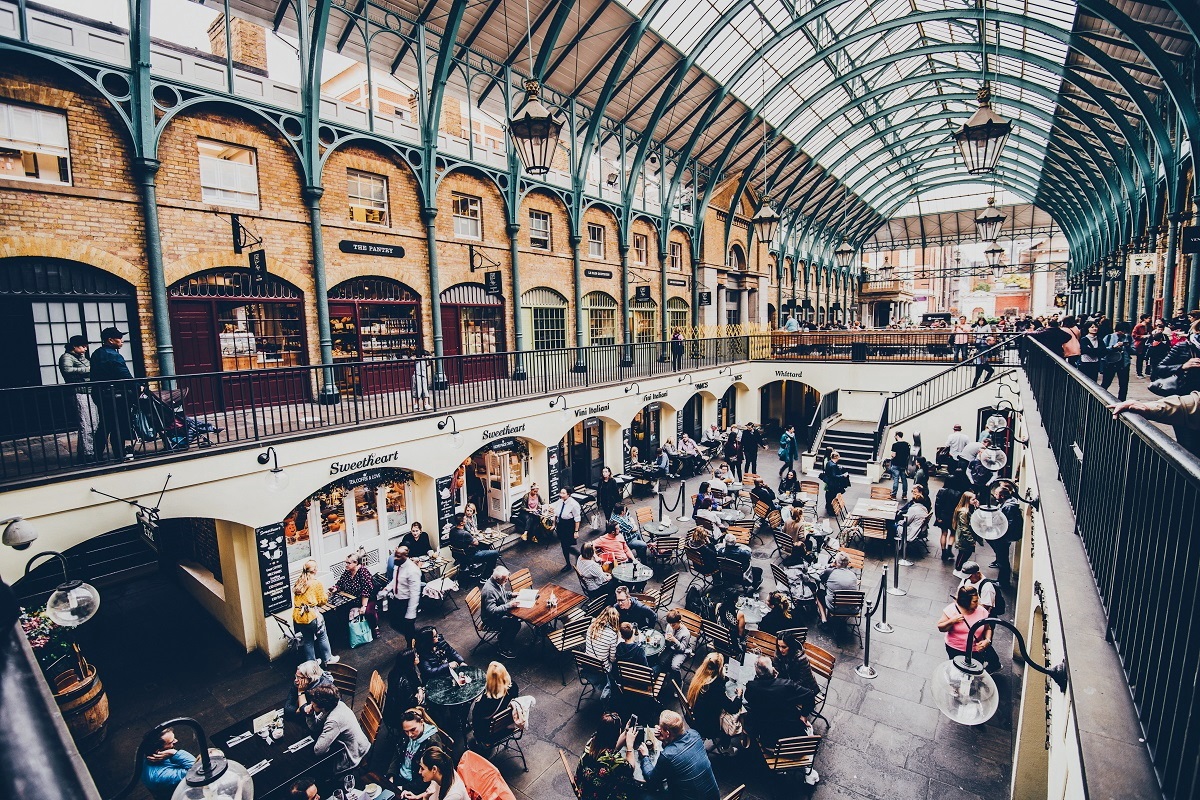
Covent Garden is the name of a neighborhood in London, and for many the name is almost synonymous with the former fruit and vegetable market, which is today the famous Covent Garden Market.
Covent Garden Market’s market halls from 1832 are the center of true folk life and a must experience in the city. The halls were set up as a shopping center with shops, cafes and pubs in 1980, and this is still the case. In 1974, the former fruit and vegetable market was moved to a more appropriate place for the large wholesale trade in the Nine Elms district, and it is now called New Covent Garden Market.
A curiosity around Covent Garden Market is the old tube station of the same name. It is one of London’s older stations, charmingly undersized for 21st century traffic volumes, and thus has large lifts that take passengers between street level and platforms.
Imperial War Museum one of London’s large and famous museums. It was founded in 1917 in memory of the many fallen in the then ongoing First World War. The museum was housed in the glass building Crystal Palace, which was built in connection with the World Exhibition in London in 1851, and it was able to open in 1920.
In the years 1924-1936, the institution was located in the building The Imperial Institute in South Kensington; this has since been demolished. The Imperial War Museum was then set up in the former hospital, Bethlem Royal Hospital, where it is still located. The hospital building was completed in its time in 1814.
The museum started as a memorial museum for the First World War, but over time its focus was expanded to include the Second World War and then all wars and conflicts in which British soldiers or troops from the Commonwealth have participated since 1914. In the large and elegantly presented exhibitions, you can experience many themes, effects and others from different parts of wars, conflicts and participants therein.
Among other things, the situations from World War 1 battles in trenches and World War 2’s many bombings of London are shown very vividly. You can see things like planes, tanks and rockets such as the Harrier and Spitfire, a Soviet T-34 and a German V2 rocket.
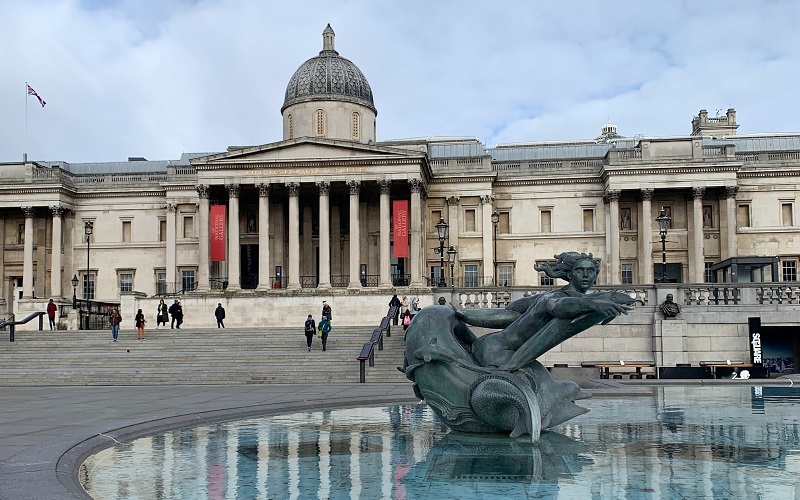
Trafalgar Square is one of the city’s oases, where people meet in style when the weather is good. The square is named after the Battle of Trafalgar, where the British fleet defeated France and Spain during the Napoleonic Wars. The naval battle took place on 21 October 1805.
The square was formerly home to royal stables, while the current Trafalgar Square was laid out from the 1820s to Sir Charles Barry’s completion in 1845. More buildings were erected around the square after the clearing of the stables, which took place from 1826.
The central decoration of Trafalgar Square is two fountains and a monument to the naval battle which was victorious for England in 1805; Nelson’s Column/Nelson’s Column. The column is 56 meters high and in the Corinthian style. The monument was dedicated in 1843 and it was Edward Hodges Baily who created the 5.5 meter tall statue of Nelson which stands on top of the monument’s column. Of the other monuments in Trafalgar Square, you can see, for example, statues of Sir Henry Havelock and Sir Charles James Napier.
To the east of the square is the pillared South African embassy, South Africa House, which was inaugurated in 1933. Among the events that have taken place in this house was Prime Minister Jan Smut’s stay during World War II, where he led the South African troops precisely from South Africa House.
To the north is the central building that houses the British National Gallery, and to the west is Canada House, built 1824-1827. Canada House is part of the Canadian Embassy in London.
The southern part of the square itself is the Charing Cross roundabout, in the middle of which you can see an equestrian statue of King Charles I of England, who reigned 1625-1649. The statue was made by the French sculptor Hubert Le Sueur in 1633. This very place is the official center of London, and kilometer indications in the city and the country are measured from here. The name Charing Cross comes from the so-called Eleanor Cross, which King Edward I erected twelve at different places in England in 1291-1294 as a memorial to his wife.
The National Gallery is an art museum that houses London’s finest collection of paintings. The collection and thus the museum was founded in 1824. It contains a large amount of works from 1200-1900 by Europe’s leading artists, and among many highlights, for example, you will find some of the artist van Gogh’s sunflowers here.
The National Gallery was established with the British government’s purchase of 38 paintings from the heirs of art collector John Julius Angerstein. The collection grew rapidly through both purchases and donations, and to house the ever-larger gallery, the monumental museum building was erected in 1832-1838. The facade facing Trafalgar Square still stands as William Wilkins’ original building, while the rest is the result of ongoing extensions. The museum’s first years from 1824 were located at 100 Pall Mall, which was Angerstein’s former residence.
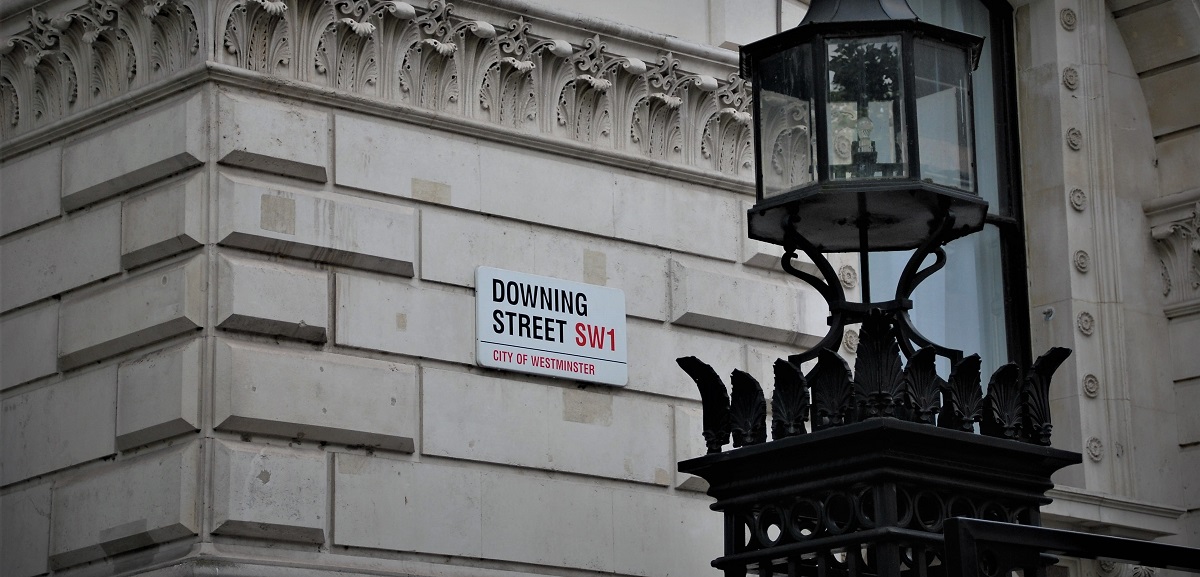
In the small street Downing Street you will find probably the most famous residence in London, namely the official residence of the British Prime Minister. The residence has been here since 1735, and with the status of the house there is no access for visitors.
There are around 100 rooms in the building, which, in addition to the Prime Minister’s residence, contains floors with offices, meeting rooms and official reception rooms, which are used, for example, for receiving and entertaining guests.
The address 10 Downing Street now consists of three original houses that were built together in the 18th century. The central house was built in 1682-1684, and King George II offered the house to Sir Robert Walpole in 1732. Walpole built the houses together and handed them over as the official residence of the country’s so-called First Lord of the Treasury, which is today one of the Prime Minister’s titles.
The street’s name comes from Sir George Downing, who had the original 17th-century house built with a distinguished view of St. James’s Park. Downing’s original thought as a housing investor was to build fine townhouses for rental to the better clientele.
Piccadilly Circus is one of London’s central squares, where there is always hectic activity. Especially in the evening, all the neon advertisements on the buildings at Shaftesbury Avenue and Glasshouse Street are an impressive sight, and here you can feel the intensity of the big city.
The first electric advertisement was set up in 1910, and since then more and more have been added. In the square itself, you can also see the Shaftesbury Monument fountain, which was erected in 1893 and is the world’s first to be made of aluminium. The monument is named after the British philanthropist Lord Shaftesbury, who was also a politician in the Victorian era.
Buildings include the Criterion Theater from 1874 on the south side, and to the north-east the 19th-century music hall London Pavillon, which originally opened in 1859 as a concert hall. Between 1912 and 1936, musicals were staged here, and subsequently the beautiful building was used as a theater and since then as a shopping centre.
Piccadilly Circus’ history goes back to 1819, when the square was laid out as a link between the streets Regent Street and Piccadilly. The name Circus comes from the Latin term for a roundabout or round square. The name Piccadilly comes from the word piccadill, which was a garment that was fashionable in the 16th-17th centuries. A tailor in the area was known to sell these, and thus the place name was used here.
The beautiful St James’s Park is a large green area that lies between the government grounds on Whitehall Street and the Regent’s residence, Buckingham Palace. The park in its current form was designed from the 1820s on the former royal hunting grounds, and both it and the neighborhood have been named after a now former hospital for lepers, which was dedicated to the disciple Jacob.
The park was laid out around a central lake, St James’s Park Lake, in which you can see the islands of West Island and Duck Island. Around the lake you can see many birds, such as some pelicans, which originate from a gift from Russia’s ambassador in 1664. In the park, you can also pass the Blue Bridge, from which there is a nice view of Buckingham Palace.
The park’s history began with King Henry VIII’s purchase of this area from Eton College in 1522. Before that, the king had acquired York Place from Cardinal Wolsey. York Place was immediately to the east of the open country and was rebuilt as the Palace of Whitehall, and the green area provided a suitable park and hunting ground for the new royal palace. When James I ascended the throne in 1603, he had the area laid out as a landscape park with camels, crocodiles and other wild animals. Several redevelopments took place and the current lake was at one time a meandering channel through the entire park.
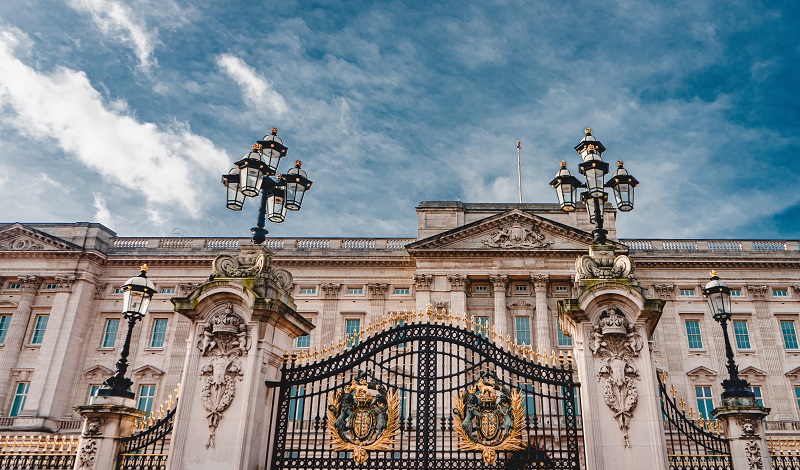
Buckingham Palace is the residence and the primary seat of administration for the monarch of the United Kingdom, and thus of course also England. However, the history of the castle did not start as a royal residence, but as Buckingham House, which was built in 1703 as the Duke of Buckingham’s town house. In 1761 King George III bought Buckingham House and fitted it out as a private residence for Queen Charlotte; thereby it became known as The Queen’s House.
The building was expanded several times, and in the 19th century three additional wings were built, so that the facility became four wings around an inner courtyard. The place became the monarch’s residence with Queen Victoria’s accession to the throne in 1837. In the late 1800s and early 1900s, the castle was rebuilt, including the eastern facade, which contains the balcony on which the royal family usually gathers when there are events with citizens present and visitors outside Buckingham Palace.
The dimensions of the castle are 120×108 meters in primary floor area and 77,000 floor meters. The piano nobile, which is the most significant part of the castle, lies to the west towards the castle park. Facing the park from the south are the State Dining Room, Blue Drawing Room, Music Room, White Drawing Room and Royal Closet, while the Green Drawing Room and Throne Room are opposite these in the same building wing.
The rooms of the west wing are joined by the 50-metre-long corridor Picture Gallery, where paintings by Johannes Vermeer, Rembrandt and Anthony van Dyck, among others, hang. To the east and thus in the direction of St James’s Park, the Balcony Room is centrally located and the Yellow Drawing Room and Chinese Luncheon Room to the south and north respectively. Elsewhere in the castle, there are rooms named after visits to Buckingham. This applies, for example, to the 1844 Room, which commemorates the state visit of Russia’s Tsar Nicholas I, and the 1855 Room in honor of France’s Napoleon III. The largest hall is Queen Victoria’s State Ballroom, where state banquets and other major representative events are held.
There are annual periods of access to parts of Buckingham Palace; including not least the beautifully decorated State Rooms. The palace is owned by the state and not the monarch, and this ownership has created the increased opportunity to look more closely at this royal and political center of the British world.
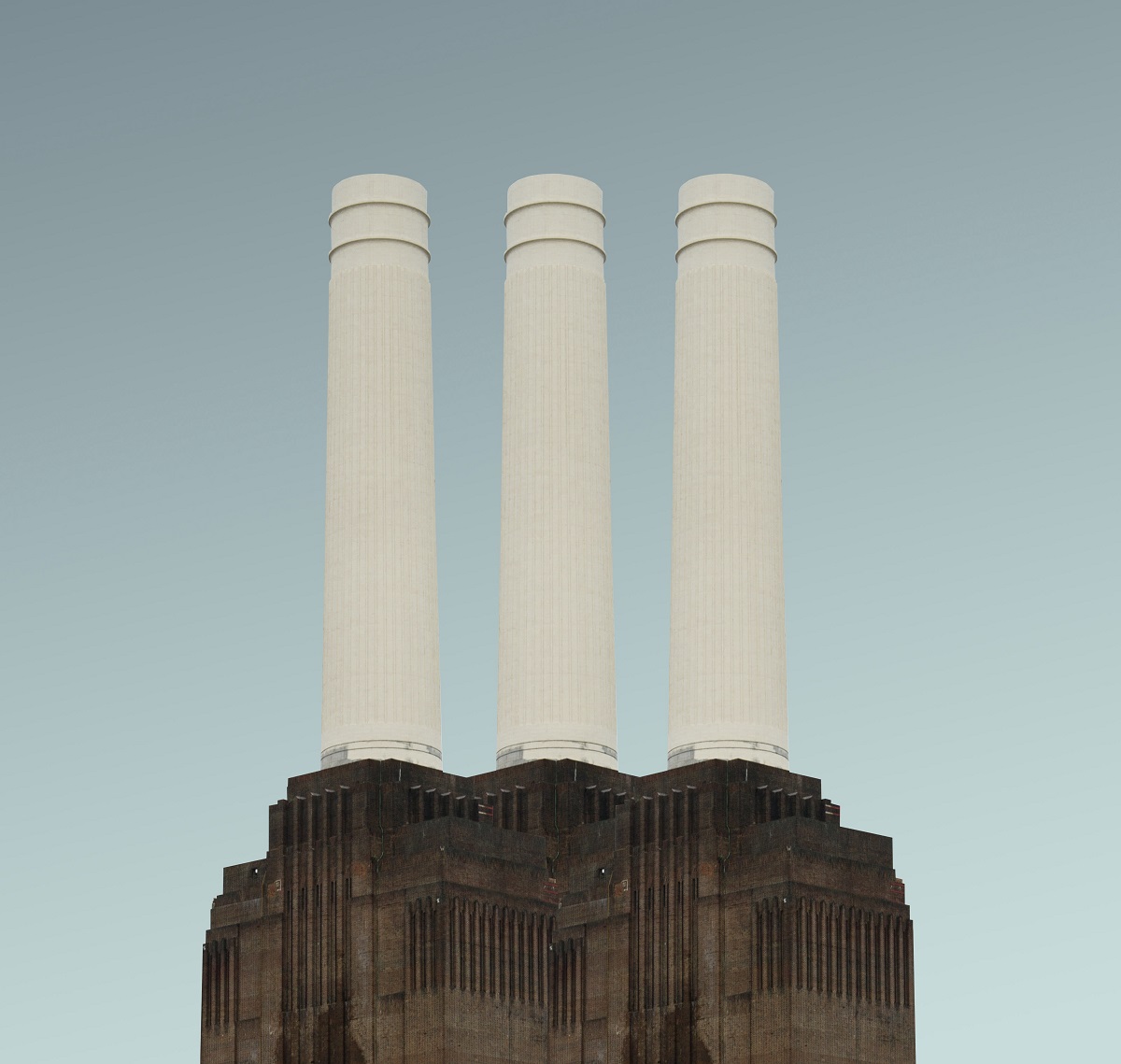
Battersea Power Station is an iconic power station that opened in the first phase in 1929 in a stately and monumental Art Deco style. The power plant was built as Europe’s largest brick building and largest power plant of its kind.
After the first phase with two chimneys, the power plant was expanded after World War II, and in 1957 it reached full operating capacity. The plant closed in 1983 and has since stood with its four chimneys and its imposing exterior on the south bank of the Thames. Since then, several projects have been presented for the reuse of the former power plant.
In 2012, it was decided to renovate and redecorate the power plant and at the same time create a new area with housing, offices, shopping, recreation and exciting modern architecture with the plant as the central element. Due to the building’s conservation status, the exterior will not be altered, just as the chimneys have been rebuilt with plans for an observation deck in one of them.
The Shard is the name of London’s 309 meter high and distinctively shaped skyscraper that towers over the London Bridge district. The 87-story, pyramid-shaped building began in 2009 and was inaugurated on July 5, 2012. At the time of its inauguration, it was the tallest completed building in Europe, excluding TV towers and the like. Shortly afterwards, however, several even taller buildings were inaugurated in Moscow. The Shard was also only surpassed in terms of height in England by the broadcasting tower at Emley Moor with a height of 330 metres.
The Shard contains both housing, offices and a hotel. For visitors, the observation deck The View from the Shard is particularly interesting because here you have a one-degree view of London and the surrounding area. There are both indoor and partially outdoor areas, and the highest height is 244 meters above street level. On this 72nd floor you are on the top floor; the remaining towards number 87 form the spire of the building.
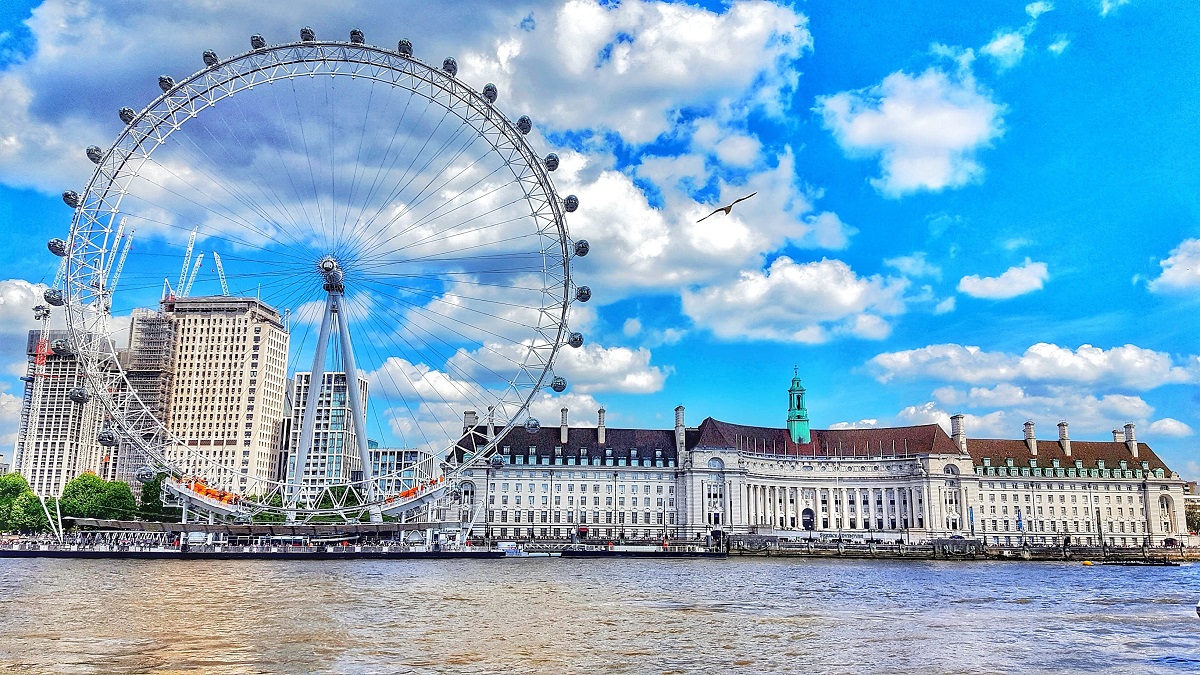
London Eye is a Ferris wheel and one of London’s popular attractions with a prime location in the heart of the English capital. At the time of its opening, the London Eye was the world’s largest Ferris wheel, but since then taller wheels have been opened in, among other places, the American Las Vegas.
The London Eye was built for the Year 2000 celebrations and the first test run took place on 31 December 1999, while the first ride with passengers started on 1 February 2000. The view from the closed cabins of the 135 meter high wheel is exceptional. A trip around takes 30 minutes.
Monument is a 62 meter high column that was erected to commemorate the city’s great fire in 1666. The official name is precisely Monument to the Great Fire of London. The location and height were chosen because the devastating fire started exactly 62 meters from the foundation of the column. It happened on 2 September 1666 in the bakery Faryner’s Bakery in Pudding Street. The building Faryners House stands on the site today, and there is a commemorative plaque on the exact spot where the fire started, which lasted three days and destroyed the town center and more than 13,000 houses.
The style of the column is Doric, and it was built in Portland stone in the years 1671-1677. At the top is a viewing balcony and a gilded urn with fire. Inside, it is a spiral staircase that gives access to the top of the monument, from where there is a fine view of the city. When the column opened, the 311 steps to the top were the way to London’s highest vantage point.
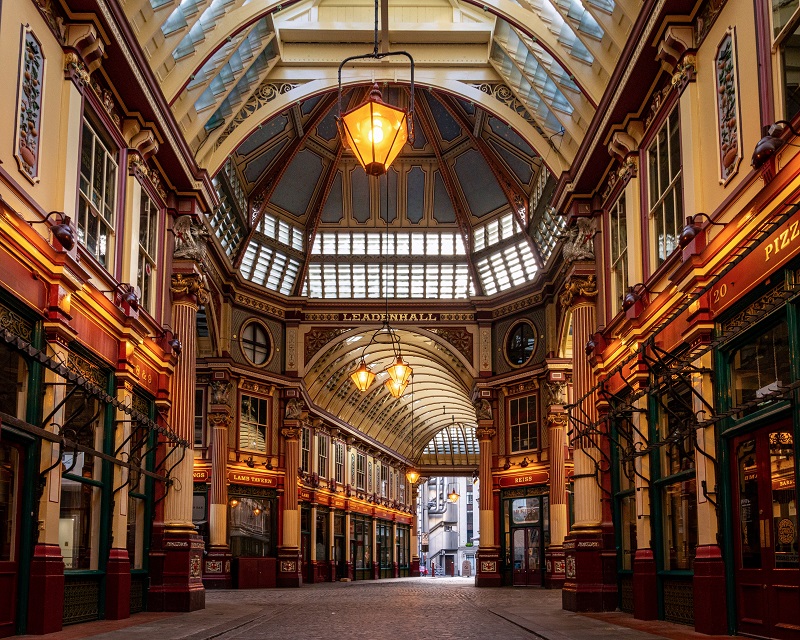
Leadenhall Market is a covered shopping arcade in elegant 19th century Victorian style. The market consists of two intersecting market arcades with a central dome where the streets meet. The beautiful building was designed in 1881 by Sir Horace Jones, who was also behind other market buildings such as in the London district of Smithfield. The main entrance is on Gracechurch Street, and from here awaits a beautiful and historic London market.
Leadenhall Market’s location is on the site of the center of Roman Londinium. Londinium was behind city walls and central in the street network was the Forum, which made up this place. In British times, the site developed again into a market place from the 14th century, and over the centuries it was one of London’s best places to buy meat and fish.
St. Mary-le-Bow is a church whose history goes back at least to the 11th century, as a version of the church was destroyed during a tornado in 1091. Ecclesiastically, the church is considered one of the most important in London, and it was then also one of the first to be rebuilt after the fire that struck and destroyed London in 1666.
St. Mary-le-Bow was rebuilt to a design by Christopher Wren in the years 1671-1673, and the 68 meter high church tower was completed in 1680. The church was destroyed by German bombardment on 10 May 1941 and subsequently rebuilt, so that today you can again experience its beautiful and elegant church space.
The bells in the church are quite famous, as the BBC World Service started using them from the 1940s in connection with various broadcasts. It is also said that you are only truly Cockney if you were born within earshot of The Bow Bells.
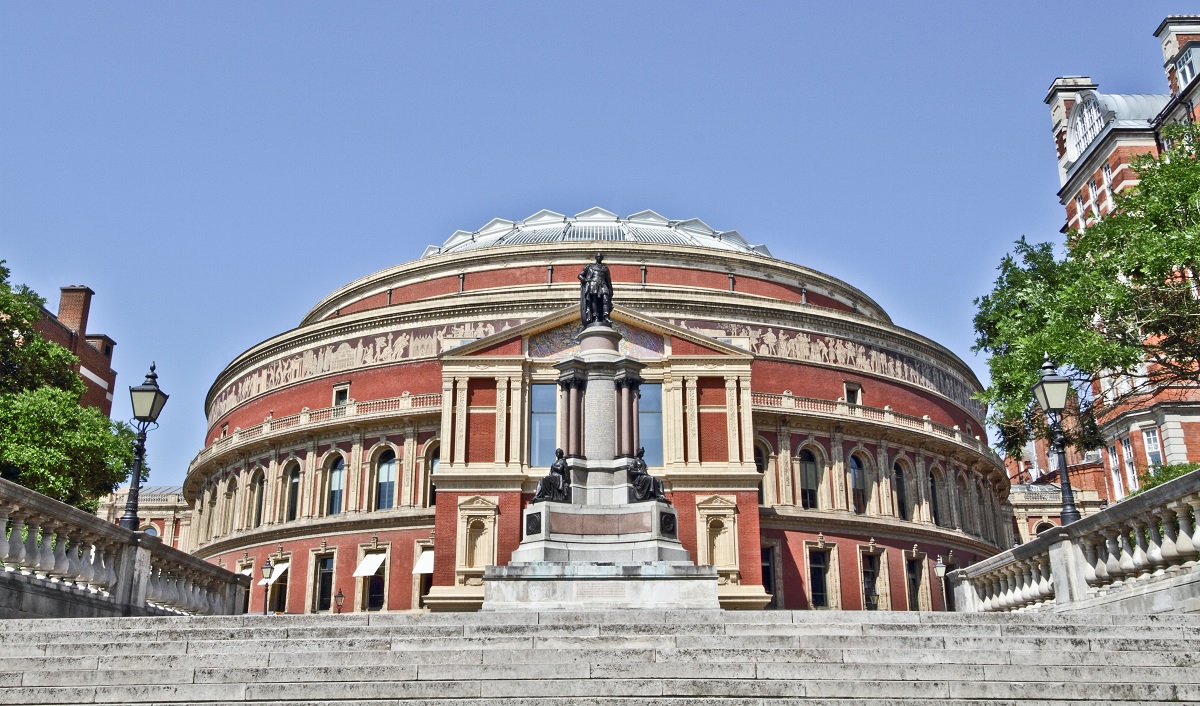
The Royal Albert Hall is a concert hall named after Queen Victoria’s husband Prince Albert. The Royal Albert Hall was inaugurated in 1871 and is home to the so-called Promenade Concerts/The Proms, which each year end with the final and very pompous concert known as the Last Night of the Proms.
The concert hall is also part of the many great buildings and institutions in the area of London dedicated to art and science. Around the Royal Albert Hall you can see a frieze that reproduces various triumphs for art and science.
Both inside and out, the Royal Albert Hall is a very beautiful and distinct building, and the location opposite Hyde Park to one side and the Royal College of Music is a fitting backdrop. Around the Royal Albert Hall you can also enjoy the view of other beautiful redstone buildings.
For many, the department store Harrods is the epitome of shopping in the English capital. A colossal range of goods combined with the traditional decoration in some of the departments makes the place worth seeing. Many people especially think of Harrod’s classy Christmas decorations, which are also a beautiful setting for a trip to the store in December.
The name Harrods comes from Charles Harrod, who opened his first store in London in 1824. It happened at the address 228 Borough High Street in the borough of Southwark. In 1849 Harrod bought a shop at the current address on Brompton Road. This happened, among other things, to profit from the industrial world exhibition, which was to be held in nearby Hyde Park. The shop had a salesroom and Charles Harrod employed two assistants and a delivery boy. In the following decades, the business grew rapidly, and more and more of the neighboring houses were bought in order to expand.
In 1905, the current building was opened, but before then English engineering history was written. It happened on 16 November 1898, when the country’s first escalator was put into use. To entice customers to try the new decor, a brandy was served at the top of the stairs.
During a visit to Harrods, you should take a walk around the beautifully decorated sales rooms on the ground floor. There are several with special themes such as The Egyptian Room, and there are exciting departments where delicacies and other food are sold.
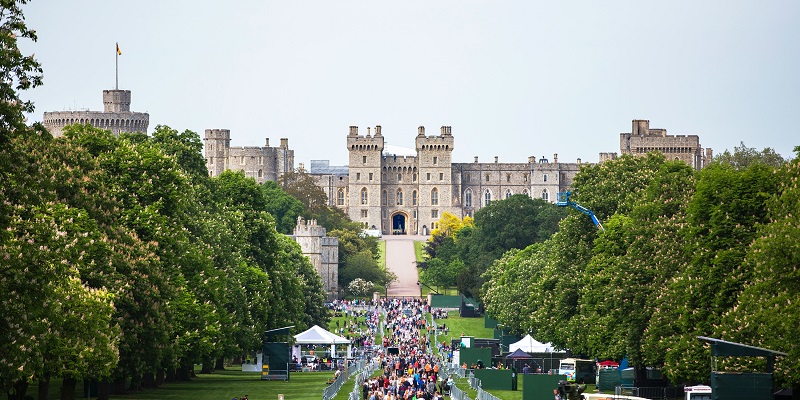
The town of Windsor lies beautifully on the River Thames west of London. The city is not only home to the royal family’s castle and castle, Windsor Castle, but also to the traditional educational institution Eton College. You can also take a walk along the main street High Street, where you will find, for example, the atmospheric town hall, Windsor Guildhall, which was built from 1687. In the street plan of the town hall building is an open colonnaded hall that was formerly a market place.
Windsor Castle has been the home of England’s kings and queens for over 900 years, and it is today one of the official royal addresses. The history of the castle started with William I the Conqueror, who built the original castle raised above the landscape from 1078. It was to stand as the western counterpart to the king’s Tower of London to the east of the city. In this way, London could be defended along the entire river.
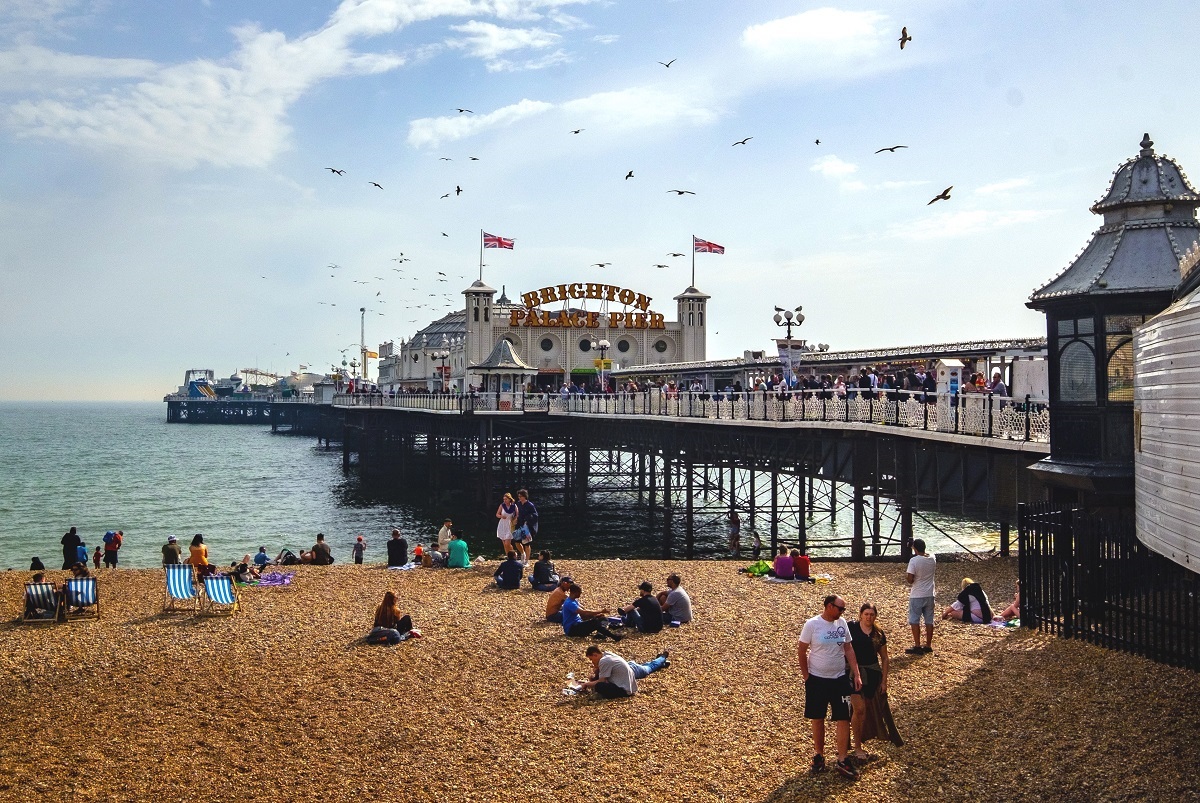
Brighton is a fashionable seaside resort located on the south coast of England. Its history goes back to Celtic settlements, and then the Romans conquered the area along with the rest of England. During this time, the Romans built villas in the city. Later the village of Bristelmestune was referred to, and at the end of the 11th century Brighton was a fishing village with around 400 inhabitants.
The population increased over time to 4,000 in the middle of the 17th century but decline hit the city and the number of inhabitants was halved. In the latter half of the 18th century, however, Brighton boomed, and this time it was tourists to the city’s baths who created the growth. Hotels and more were built in the Victorian era, and Brighton was home to more than 120,000 people in 1901.

Cambridge is a city located on the River Cam in the area north of London. The city was already settled in Roman times, and after the Roman Empire conquered England around the year 40, Cambridge became an important military post with the name Duroliponte. After the retreat of the Romans, the city was settled by anglers, and Vikings arrived in 875.
Trade with the Vikings made the city grow. Later, the Anglo-Saxons arrived, and William the Conqueror built a castle in the town in the 11th century. The first college in Cambridge was founded in 1284 by people from the university town of Oxford, and today there are more than 30 separate colleges on the campus, which over the centuries have grown to be the city’s trademark.
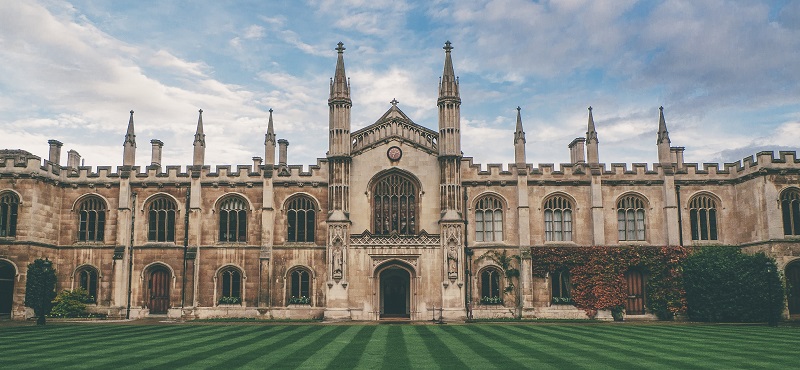
Oxford is a city located on the River Thames in the area northwest of London. The town is known historically from 911, when it was mentioned as Oxnaforda. Later in the century, Oxford was burned down by attacking Vikings, and it happened again in the year 1009. During this time, several meetings were held in the so-called witenagemot in Oxford, and it was at a meeting here in 1016 that the Danish King Canute was recognized as King of England.
The city developed during this time. Bridges were built to the city, and from 1096 there was academic teaching in Oxford. In 1790, the Oxford Canal opened to Coventry and Birmingham’s industrial areas, and this gave new growth to the city, which itself experienced a boom after the industrial revolution with, for example, car production.

The prehistoric monument Stonehenge with its stone circles has puzzled the modern world for many years. The question is why and how these huge megaliths have been erected here on Salisbury Plains. It is estimated that the ramparts surrounding the facility are from the Neolithic age, around 5,000 years ago, while the stone setting is estimated to be 4,000-4,500 years old, which means from the Bronze Age.
Stonehenge fascinates with its mystery and with what the facility has been used for. There are also several theories about how it was built. The monument forms a large double circle of stones, of which the outer ones are the largest, and they were transported here from several hundred kilometers away. There have been several theories about the use of stone circles like Stonehenge. It is believed that the place has been used as a center for healing, where both patients and experts were attracted.
Covent Garden
coventgardenmarket.com
87-135 Brompton Road
harrods.com
109-125 Knightsbridge 109-125
harveynichols.com
278-308 Oxford Street
johnlewis.com
Sloane Square/King’s Road
peterjones.co.uk
400 Oxford Street
selfridges.com
151 Queensway
whiteleys.com
Bond Street, Brompton Road, Cork Street, Duke Street, King’s Road, Knightsbridge, New Bond Street, Oxford Street, Piccadilly Circus, Regent Street, Sloane Square, Tottenham Court Road
Legoland
Windsor, 40 km/25 mi W
legoland.co.uk
London Aquarium
Belvedere Road
londonaquarium.co.uk
London Dungeon
Tooley Street 28-34
thedungeons.com
London Zoo
Regent’s Park
londonzoo.co.uk
London Transport Museum
Covent Garden
ltmuseum.co.uk
Museum of Natural History
Exhibition Road
nhm.ac.uk
Science Museum
Exhibition Road
sciencemuseum.org.uk
When the Romans invaded England in the year 43, they were to cross the River Thames, and here they built a wooden bridge. It was close to today’s London Bridge, and the bridge quickly became the hub of traffic between the South and the North, and in that way London’s development began.
The city itself was established as Londinium about seven years after the Roman conquest, and after that the development went strong. Many buildings were erected during the early period of growth in the city, crowned by the fact that Londinium became the Roman administration seat of the 100th century in the province of Britannia; it replaced Colchester, which until then had that status.
At this time, the population was already around 60,000. Forum was set up at today’s Leadenhall Market, and the first temple at St. Paul’s was opened. The city was concentrated north of the Thames on the site where Monument was later erected. There were swimming facilities, temples, an amphitheater and other major public facilities.
Around the year 200, the Roman province of England was divided into two, and London became the capital of the most important part, while York became the capital of the second part. In doing so, the city’s enduring status as a leader had been emphasized.
In the 200s, Londinium was exposed to several attacks from the seaside, which led to the city’s defense being expanded. It happened with walls along the Thames where the threat came from. To that end, six of the city’s historic city gates were built; Aldersgate, Aldgate, Bishopsgate, Cripplegate, Ludgate and Newgate are the modern names for these gates.
Defense walls were built around Londinium, but Roman times in Britannia did not continue through the centuries. In the 400s, Roman power in the area ceased and Anglo-Saxon immigration started. Traces of an Anglo-Saxon cemetery have been found around Covent Garden, and it is believed to date back to the 500s and perhaps even 400s.
The Anglo-Saxon city was located a little west of the Roman city, and thus along The Strand between Aldwych and Trafalgar Square in the current town plan. The town was known as Lundenwic and over the years grew to over 10,000 inhabitants in the Anglo-Saxon era.
Around the year 600, the first Christian cathedral on St. Paul’s built, and the Pope’s emissary was to create an archdiocese seat. He chose Canterbury instead of London as a seat, but the city grew nonetheless; primarily due to the good location of the Thames, which meant increased trade and more new districts.
In 842 and 851 London was attacked by Danish Vikings, and in 865 they invaded England. In the winter of 871-872, the Vikings resided in London and retained dominion over the city until the year 886, when Alfred the Great of Essex’s troops conquered it.
The town was then placed under Mercia with Ealdorman Æthelred as leader. The city was then called Lundenburh, and the city was fortified with new defenses and re-established Roman walls. The city’s core was also moved east and behind the Roman walls again. Furthermore, a fortified bridgehead was established south of the Thames in the form of Southwark with the then name Suthringa Geworc. The old Lundenwic was called Ealdwic with reference to the old settlement, and from that comes the Aldwych of today.
Ethelred died in 911, after which Lundenburh became subject to Wessex and thereby the English kings. The city had already become the country’s most important commercial city in the 920s, and in 978 the king made London the capital.
However, the Danish Vikings still attacked London. The city resisted an attack under the Viking king Svend Tveskæg in 994, but the attacks continued despite the defeat. In 1013, the Vikings overcame the English resistance, and Svend Tvesk beard was crowned English King.
Svend Tvesk beard died shortly after, and the former English king was reinstated for a period until Svend Tvesk Beard’s son Knud again attacked and conquered Lundenburh and England. The Danish Vikings first gained dominion over London and England north of the Thames, and then Knud conquered the rest of the country. The Viking Knud was thus new king over both London and the rest of England.
After the first Danish Viking kings in England, Knud’s dynasty went extinct, and the throne then passed to Anglo-Saxon Edvard the Confessor. Under Edvard, Westminster Abbey was founded, and the King was primarily in precisely Westminster.
Edvard The acquaintance died in 1066, leaving no clear and formal successor. Jarl Harold Godwinson was elected king and crowned at Westminster Abbey, but he did not sit long on the throne. William of Normandy had claimed the throne as Edvard the Confessor’s successor, and he attacked England and won the throne and power of the Battle of Hastings on October 14, 1066. William and the Normans went to London, and after the conquest of the English capital, William was crowned in Westminster Abbey as King William I.
London flourished vigorously in the following years; among other things through the rights the city got to the surrounding land, but much was also built as a Norman fortification of the city. The Tower of London to the east and Windsor Castle further to the west were erected in defense of the city; Tower was the first stone castle in England, which emphasized the importance of both the castle and London.
Administratively, after the French model of 1191, London was equipped with a civilian government led by a mayor. One of the initiatives was to prevent the frequent fires by building firewalls in stone.
London’s general political influence increased significantly in the 12th century, where it had previously been only a trading center. Westminster Palace was erected and with it the political power of the country was established.
Of other construction in the former Norman era was also the famous London Bridge. The plant was started in 1179 and the bridge could be commissioned in 1209. The bridge was important to the city and its trade, and it was the only bridge across the Thames until 1739.
During the 13th century, many monks came to the country, and they quickly built fortunes to erect many of the great church buildings one can see today. The number of churches followed a growing population. Around the year 1100, about 15,000 lived in London, and by the year 1300 the number had grown to about 80,000.
London’s rising international role also started part of the city’s development. The industries of the city and the busy port were important parts of the rapidly growing production and trade that characterized the English capital.
With the start of Tudor’s house as regent with Henry VII in 1485, London again saw a building boom, and in particular many mansions and palaces were built.
Among other things, the 16th century of the Tudor period was marked by the Protestant Reformation, and London was the center of the English Protestants. The new religious currents came from the European continent to London through the city’s many international connections. In London, the Protestant ideas could spread through the city’s media and intellectual class.
King Henry VIII started the dissolution of the Catholic orders and monasteries in England in 1536, and it became of great importance to London. Of course, the church was reformed religiously, but as the Catholic churches and ordinances owned large parts of the city, the town’s property conditions also changed. Many of the church’s mansions were taken over by various wealthy noble families.
The 16th century was also a century in which London and England seriously developed a trade with large parts of the world. Russia, America and India were important trading places for the English, and trading companies such as Muscovy Compnay and the British East India Company gained considerable power in the growing empire.
At the same time as trade developments, London’s population continued to rise dramatically. There were about 50,000 living in London in the 1530s, and at the beginning of the 1600s there were approximately 225,000 citizens in the city.
London had been considerably expanded, and through the 17th century the city grew seriously beyond the old city limits. Among the new inhabitants were, for example, some aristocrats and the English country nobility who built residences for residence in London, where they enjoyed the social life of the city.
During the 17th century, however, London was also hit by several major accidents. The sanitary conditions gave rise to the spread of disease, and several outbreaks of plague ravaged the capital. Outbreaks in 1665 and 1666 are believed to have killed 60,000 people or about a fifth of the city’s inhabitants.
London was gradually a very large city with dense settlement, and in 1666 another accident struck London; the city’s big fire, which laid many neighborhoods in the old London desert.
On Sunday, September 2, 1666, a fire started at 1 a.m. in a bakery in the street of Pudding Lane. There was easterly wind, and it quickly caught the flames, which spread to several buildings, many streets and entire neighborhoods. The fire was first extinguished on Thursday, and the many days of fire had left its mark in the cityscape.
About 60% of the City had been destroyed by the fire, and among other things, it had damaged no fewer than 87 parish churches, the old St. Paul’s Cathedral, the city’s stock exchange and a host of other buildings.
After the fire, London was to be rebuilt, and just days after the fire, the King was presented with three different proposals for new town plans by Christopher Wren, John Evelyn and Robert Hooke respectively. The plans offered rectilinear streets and large spaces according to European models of the time. Instead of these, London was developed from the street network from before the ravages of the fire.
After the fire in 1666, the rebuilding of the English capital began. Only wood was used for doors, windows and storefronts; otherwise the new buildings should be of stone to protect against any future fires.
Christopher Wren’s proposed new town plan was not realized, but Wren was spearheaded for the rebuilding of countless burned-out and destroyed churches as well as for the construction of a new St. Paul’s Cathedral. Wrens St. Paul’s stands as one of London’s major sights, just as many of his churches are beautiful contemporary architectural gems.
Other large plants also saw the light of day in the latter half of the 1600s. The royal power, several nobles and wealthy men erected new residences; eg King William III’s establishment of Kensington Palace as a large residence following the acquisition of the property in 1691.
Throughout the following century, the rapid development of London continued. The city gained further political power in 1707, with the parliaments of England and Scotland assembled under a British parliament in the unified country of the United Kingdom.
Later in the 18th century, the Seven Years’ War broke out between some of Europe’s leading powers. The war was fought in 1756-1763, and one of the most important achievements for Britain was the French defeat, which ended France’s political dominance in Europe and much of North America. It gave way to Britain, which at that time strengthened its position in India and North America, among others, and it benefited the London commercial houses greatly.
In the mid-18th century, London was expanded with several new districts, giving new space to the city’s continued growth. A few decades later, George III purchased the mansion Buckingham House by the Duke of Buckingham; it was in 1762, and over the next several years British regents expanded the mansion into a new magnificent residence castle.
New industries also came to town, and in the 1700s Fleet Street was developed as the home of the press, and from this a number of newspapers were published over time. The trade in the city was given infrastructurally better opportunities when it was decided to establish a new bridge across the Thames. It happened with the opening of the Westminster Bridge in 1750 and before that all traffic had passed over the London Bridge.
London’s population numbered around a million around 1800, making the English capital the world’s largest city. The city was thriving, and the wealth of the wealthy increased, while there was still marked slum and poverty for others. Part of the city’s life was described by Charles Dickens in Oliver Twist, while the trade prospered, and London’s political leadership role in the world merely expanded.
The area of the city was significantly expanded and the population increased to 2.7 million in 1851, with the industrial revolution further developing London and England very rapidly. The railroad was a reason for the rapid growth. With it, train connections were made to suburbs where the middle class could live while working in central London.
The first London railroad was opened in 1836 and it connected the London Bridge with Greenwich. In the following decades, large terminus stations opened in many parts of the city, and in 1863 the world’s first subway was opened in London.
London, England and the United Kingdom were at their international highs in the mid-1800s. The splendor and empire were displayed at the Great Exhibition in 1851; the exhibition was held in the famous Crystal Palace.
London’s population grew throughout the century, and from 1 million inhabitants in 1800, 6.7 million lived at the turn of the 20th century.
At the end of the 19th century, London gained more economic and political competition among the world’s major cities, with not least Paris and New York beginning to make London the rank of battle as the center of much of the world’s economy and politics.
However, London continued its development into the new century. The infrastructure was expanded with subway extensions, and a tram network was also built in the city streets.
The 1900s started with a large British empire ruled from London, but independence requests from countries and the impending world wars changed that status by bite. During World War I, London was attacked and bombed by German zeppelin bombers, and several attacks destroyed buildings in the city.
After being hit by the international economic crisis in the 1930s came World War II, which went hard over London. Many children had been evacuated to rural areas in England, and the remaining population lived with shelters and fears of the many German bombings that repeatedly struck, especially between September 1940 and May 1941. V1 and V2 rockets were used as bombs from 1944 , and a total of about 30,000 were killed during the attacks. Many buildings were also crushed and large parts of London had to be rebuilt after the end of the war in 1945.
A great reconstruction work was started from 1945, but it took many years before the war’s years were healed. Meanwhile, however, there was also time for other and more joyous events such as the Olympic Games held in London in 1948. Three years later, The Festival and Britain were conducted, and the activities gave new optimism and faith in the future.
There was a shortage of housing in post-war London, and through the 1950s and 1960s many concrete blocks of flats were erected around London, giving the city a new character. New neighborhoods and suburbs also emerged during this time. The decades were also a period of great immigration to London from many former colonies and parts of the British Empire, and they clearly changed the city’s population composition.
From the 1960s, London became a cultural stronghold where flows can surface and on to the whole world. Youth culture and Swinging London brought global interest and influence, and it continued with new wave, punk and later britpop music, among others.
Many of the formerly so large and significant industrial areas decayed in the latter half of the 20th century, but from the end of the century a development of the city occurred, and in many places the old ports and industrial buildings were brought to life through new residential, office and cultural projects. They apply, for example, to Docklands, which is an asset in an old port district, and old power plants such as Battersea Power Station.
New architecture was also instrumental in putting London on the 21st century world map. The London Eye Ferris Wheel in the Thames has become one of the city’s landmarks, and renowned architects have supplemented the city’s skyline with exciting skyscrapers such as The Shard. London hosts many global events, but few are on par with the Olympic Games, which once again came to London in 2012.
 London, England[/caption]
London, England[/caption]
Overview of London
London is the center of the British world, and as the capital of an empire, the city has for centuries been inspired by cultures around the world, and it has left its mark in the city’s streets. London is a metropolis, with something for everyone; it goes for sights, monuments, museums, activities and also the many ethnic restaurants and cultural features that are here.
The museums in London are among the finest in the world and there is something for everyone in British Museum’s fantastic collections. Imperial War Museum and Tower of London are other popular choices. You can find almost anything in the English Capital, just use your imagination and curiosity.
About the Whitehorse travel guide
Contents: Tours in the city + tours in the surrounding area
Published: Released soon
Author: Stig Albeck
Publisher: Vamados.com
Language: English
About the travel guide
The Whitehorse travel guide gives you an overview of the sights and activities of the Canadian city. Read about top sights and other sights, and get a tour guide with tour suggestions and detailed descriptions of all the city’s most important churches, monuments, mansions, museums, etc.
Whitehorse is waiting for you, and at vamados.com you can also find cheap flights and great deals on hotels for your trip. You just select your travel dates and then you get flight and accommodation suggestions in and around the city.
Read more about Whitehorse and Canada
Canada Travel Guide: https://vamados.com/canada
City tourism: https://visitwhite-horse.ca
Main Page: https://www.vamados.com/
Buy the travel guide
Click the “Add to Cart” button to purchase the travel guide. After that you will come to the payment, where you enter the purchase and payment information. Upon payment of the travel guide, you will immediately receive a receipt with a link to download your purchase. You can download the travel guide immediately or use the download link in the email later.
Use the travel guide
When you buy the travel guide to Whitehorse you get the book online so you can have it on your phone, tablet or computer – and of course you can choose to print it. Use the maps and tour suggestions and you will have a good and content-rich journey.


Trafalgar Square is one of the city’s oases, where people meet in style when the weather is good. The square is named after the Battle of Trafalgar, where the British fleet defeated France and Spain during the Napoleonic Wars. The naval battle took place on 21 October 1805.
The square was formerly home to royal stables, while the current Trafalgar Square was laid out from the 1820s to Sir Charles Barry’s completion in 1845. More buildings were erected around the square after the clearing of the stables, which took place from 1826.
The central decoration of Trafalgar Square is two fountains and a monument to the naval battle which was victorious for England in 1805; Nelson’s Column/Nelson’s Column. The column is 56 meters high and in the Corinthian style. The monument was dedicated in 1843 and it was Edward Hodges Baily who created the 5.5 meter tall statue of Nelson which stands on top of the monument’s column. Of the other monuments in Trafalgar Square, you can see, for example, statues of Sir Henry Havelock and Sir Charles James Napier.
To the east of the square is the pillared South African embassy, South Africa House, which was inaugurated in 1933. Among the events that have taken place in this house was Prime Minister Jan Smut’s stay during World War II, where he led the South African troops precisely from South Africa House.
To the north is the central building that houses the British National Gallery, and to the west is Canada House, built 1824-1827. Canada House is part of the Canadian Embassy in London.
The southern part of the square itself is the Charing Cross roundabout, in the middle of which you can see an equestrian statue of King Charles I of England, who reigned 1625-1649. The statue was made by the French sculptor Hubert Le Sueur in 1633. This very place is the official center of London, and kilometer indications in the city and the country are measured from here. The name Charing Cross comes from the so-called Eleanor Cross, which King Edward I erected twelve at different places in England in 1291-1294 as a memorial to his wife.
The National Gallery is an art museum that houses London’s finest collection of paintings. The collection and thus the museum was founded in 1824. It contains a large amount of works from 1200-1900 by Europe’s leading artists, and among many highlights, for example, you will find some of the artist van Gogh’s sunflowers here.
The National Gallery was established with the British government’s purchase of 38 paintings from the heirs of art collector John Julius Angerstein. The collection grew rapidly through both purchases and donations, and to house the ever-larger gallery, the monumental museum building was erected in 1832-1838. The facade facing Trafalgar Square still stands as William Wilkins’ original building, while the rest is the result of ongoing extensions. The museum’s first years from 1824 were located at 100 Pall Mall, which was Angerstein’s former residence.

In the small street Downing Street you will find probably the most famous residence in London, namely the official residence of the British Prime Minister. The residence has been here since 1735, and with the status of the house there is no access for visitors.
There are around 100 rooms in the building, which, in addition to the Prime Minister’s residence, contains floors with offices, meeting rooms and official reception rooms, which are used, for example, for receiving and entertaining guests.
The address 10 Downing Street now consists of three original houses that were built together in the 18th century. The central house was built in 1682-1684, and King George II offered the house to Sir Robert Walpole in 1732. Walpole built the houses together and handed them over as the official residence of the country’s so-called First Lord of the Treasury, which is today one of the Prime Minister’s titles.
The street’s name comes from Sir George Downing, who had the original 17th-century house built with a distinguished view of St. James’s Park. Downing’s original thought as a housing investor was to build fine townhouses for rental to the better clientele.
Piccadilly Circus is one of London’s central squares, where there is always hectic activity. Especially in the evening, all the neon advertisements on the buildings at Shaftesbury Avenue and Glasshouse Street are an impressive sight, and here you can feel the intensity of the big city.
The first electric advertisement was set up in 1910, and since then more and more have been added. In the square itself, you can also see the Shaftesbury Monument fountain, which was erected in 1893 and is the world’s first to be made of aluminium. The monument is named after the British philanthropist Lord Shaftesbury, who was also a politician in the Victorian era.
Buildings include the Criterion Theater from 1874 on the south side, and to the north-east the 19th-century music hall London Pavillon, which originally opened in 1859 as a concert hall. Between 1912 and 1936, musicals were staged here, and subsequently the beautiful building was used as a theater and since then as a shopping centre.
Piccadilly Circus’ history goes back to 1819, when the square was laid out as a link between the streets Regent Street and Piccadilly. The name Circus comes from the Latin term for a roundabout or round square. The name Piccadilly comes from the word piccadill, which was a garment that was fashionable in the 16th-17th centuries. A tailor in the area was known to sell these, and thus the place name was used here.
The beautiful St James’s Park is a large green area that lies between the government grounds on Whitehall Street and the Regent’s residence, Buckingham Palace. The park in its current form was designed from the 1820s on the former royal hunting grounds, and both it and the neighborhood have been named after a now former hospital for lepers, which was dedicated to the disciple Jacob.
The park was laid out around a central lake, St James’s Park Lake, in which you can see the islands of West Island and Duck Island. Around the lake you can see many birds, such as some pelicans, which originate from a gift from Russia’s ambassador in 1664. In the park, you can also pass the Blue Bridge, from which there is a nice view of Buckingham Palace.
The park’s history began with King Henry VIII’s purchase of this area from Eton College in 1522. Before that, the king had acquired York Place from Cardinal Wolsey. York Place was immediately to the east of the open country and was rebuilt as the Palace of Whitehall, and the green area provided a suitable park and hunting ground for the new royal palace. When James I ascended the throne in 1603, he had the area laid out as a landscape park with camels, crocodiles and other wild animals. Several redevelopments took place and the current lake was at one time a meandering channel through the entire park.

Buckingham Palace is the residence and the primary seat of administration for the monarch of the United Kingdom, and thus of course also England. However, the history of the castle did not start as a royal residence, but as Buckingham House, which was built in 1703 as the Duke of Buckingham’s town house. In 1761 King George III bought Buckingham House and fitted it out as a private residence for Queen Charlotte; thereby it became known as The Queen’s House.
The building was expanded several times, and in the 19th century three additional wings were built, so that the facility became four wings around an inner courtyard. The place became the monarch’s residence with Queen Victoria’s accession to the throne in 1837. In the late 1800s and early 1900s, the castle was rebuilt, including the eastern facade, which contains the balcony on which the royal family usually gathers when there are events with citizens present and visitors outside Buckingham Palace.
The dimensions of the castle are 120×108 meters in primary floor area and 77,000 floor meters. The piano nobile, which is the most significant part of the castle, lies to the west towards the castle park. Facing the park from the south are the State Dining Room, Blue Drawing Room, Music Room, White Drawing Room and Royal Closet, while the Green Drawing Room and Throne Room are opposite these in the same building wing.
The rooms of the west wing are joined by the 50-metre-long corridor Picture Gallery, where paintings by Johannes Vermeer, Rembrandt and Anthony van Dyck, among others, hang. To the east and thus in the direction of St James’s Park, the Balcony Room is centrally located and the Yellow Drawing Room and Chinese Luncheon Room to the south and north respectively. Elsewhere in the castle, there are rooms named after visits to Buckingham. This applies, for example, to the 1844 Room, which commemorates the state visit of Russia’s Tsar Nicholas I, and the 1855 Room in honor of France’s Napoleon III. The largest hall is Queen Victoria’s State Ballroom, where state banquets and other major representative events are held.
There are annual periods of access to parts of Buckingham Palace; including not least the beautifully decorated State Rooms. The palace is owned by the state and not the monarch, and this ownership has created the increased opportunity to look more closely at this royal and political center of the British world.

Battersea Power Station is an iconic power station that opened in the first phase in 1929 in a stately and monumental Art Deco style. The power plant was built as Europe’s largest brick building and largest power plant of its kind.
After the first phase with two chimneys, the power plant was expanded after World War II, and in 1957 it reached full operating capacity. The plant closed in 1983 and has since stood with its four chimneys and its imposing exterior on the south bank of the Thames. Since then, several projects have been presented for the reuse of the former power plant.
In 2012, it was decided to renovate and redecorate the power plant and at the same time create a new area with housing, offices, shopping, recreation and exciting modern architecture with the plant as the central element. Due to the building’s conservation status, the exterior will not be altered, just as the chimneys have been rebuilt with plans for an observation deck in one of them.
The Shard is the name of London’s 309 meter high and distinctively shaped skyscraper that towers over the London Bridge district. The 87-story, pyramid-shaped building began in 2009 and was inaugurated on July 5, 2012. At the time of its inauguration, it was the tallest completed building in Europe, excluding TV towers and the like. Shortly afterwards, however, several even taller buildings were inaugurated in Moscow. The Shard was also only surpassed in terms of height in England by the broadcasting tower at Emley Moor with a height of 330 metres.
The Shard contains both housing, offices and a hotel. For visitors, the observation deck The View from the Shard is particularly interesting because here you have a one-degree view of London and the surrounding area. There are both indoor and partially outdoor areas, and the highest height is 244 meters above street level. On this 72nd floor you are on the top floor; the remaining towards number 87 form the spire of the building.

London Eye is a Ferris wheel and one of London’s popular attractions with a prime location in the heart of the English capital. At the time of its opening, the London Eye was the world’s largest Ferris wheel, but since then taller wheels have been opened in, among other places, the American Las Vegas.
The London Eye was built for the Year 2000 celebrations and the first test run took place on 31 December 1999, while the first ride with passengers started on 1 February 2000. The view from the closed cabins of the 135 meter high wheel is exceptional. A trip around takes 30 minutes.
Monument is a 62 meter high column that was erected to commemorate the city’s great fire in 1666. The official name is precisely Monument to the Great Fire of London. The location and height were chosen because the devastating fire started exactly 62 meters from the foundation of the column. It happened on 2 September 1666 in the bakery Faryner’s Bakery in Pudding Street. The building Faryners House stands on the site today, and there is a commemorative plaque on the exact spot where the fire started, which lasted three days and destroyed the town center and more than 13,000 houses.
The style of the column is Doric, and it was built in Portland stone in the years 1671-1677. At the top is a viewing balcony and a gilded urn with fire. Inside, it is a spiral staircase that gives access to the top of the monument, from where there is a fine view of the city. When the column opened, the 311 steps to the top were the way to London’s highest vantage point.

Leadenhall Market is a covered shopping arcade in elegant 19th century Victorian style. The market consists of two intersecting market arcades with a central dome where the streets meet. The beautiful building was designed in 1881 by Sir Horace Jones, who was also behind other market buildings such as in the London district of Smithfield. The main entrance is on Gracechurch Street, and from here awaits a beautiful and historic London market.
Leadenhall Market’s location is on the site of the center of Roman Londinium. Londinium was behind city walls and central in the street network was the Forum, which made up this place. In British times, the site developed again into a market place from the 14th century, and over the centuries it was one of London’s best places to buy meat and fish.
St. Mary-le-Bow is a church whose history goes back at least to the 11th century, as a version of the church was destroyed during a tornado in 1091. Ecclesiastically, the church is considered one of the most important in London, and it was then also one of the first to be rebuilt after the fire that struck and destroyed London in 1666.
St. Mary-le-Bow was rebuilt to a design by Christopher Wren in the years 1671-1673, and the 68 meter high church tower was completed in 1680. The church was destroyed by German bombardment on 10 May 1941 and subsequently rebuilt, so that today you can again experience its beautiful and elegant church space.
The bells in the church are quite famous, as the BBC World Service started using them from the 1940s in connection with various broadcasts. It is also said that you are only truly Cockney if you were born within earshot of The Bow Bells.

The Royal Albert Hall is a concert hall named after Queen Victoria’s husband Prince Albert. The Royal Albert Hall was inaugurated in 1871 and is home to the so-called Promenade Concerts/The Proms, which each year end with the final and very pompous concert known as the Last Night of the Proms.
The concert hall is also part of the many great buildings and institutions in the area of London dedicated to art and science. Around the Royal Albert Hall you can see a frieze that reproduces various triumphs for art and science.
Both inside and out, the Royal Albert Hall is a very beautiful and distinct building, and the location opposite Hyde Park to one side and the Royal College of Music is a fitting backdrop. Around the Royal Albert Hall you can also enjoy the view of other beautiful redstone buildings.
For many, the department store Harrods is the epitome of shopping in the English capital. A colossal range of goods combined with the traditional decoration in some of the departments makes the place worth seeing. Many people especially think of Harrod’s classy Christmas decorations, which are also a beautiful setting for a trip to the store in December.
The name Harrods comes from Charles Harrod, who opened his first store in London in 1824. It happened at the address 228 Borough High Street in the borough of Southwark. In 1849 Harrod bought a shop at the current address on Brompton Road. This happened, among other things, to profit from the industrial world exhibition, which was to be held in nearby Hyde Park. The shop had a salesroom and Charles Harrod employed two assistants and a delivery boy. In the following decades, the business grew rapidly, and more and more of the neighboring houses were bought in order to expand.
In 1905, the current building was opened, but before then English engineering history was written. It happened on 16 November 1898, when the country’s first escalator was put into use. To entice customers to try the new decor, a brandy was served at the top of the stairs.
During a visit to Harrods, you should take a walk around the beautifully decorated sales rooms on the ground floor. There are several with special themes such as The Egyptian Room, and there are exciting departments where delicacies and other food are sold.
Similar to London Travel Guide
